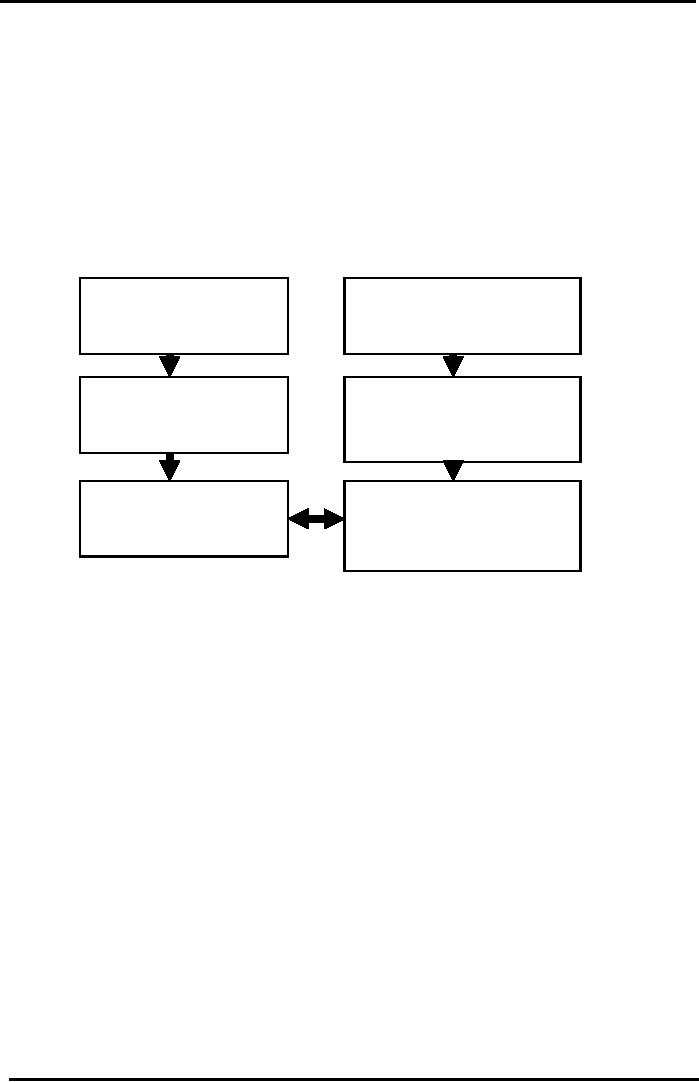 |

Financial
Management MGT201
VU
Lesson
18
COMMON
STOCKS RATE OF RETURN AND EPS
PRICING MODEL
Learning
Objectives:
After
going through this lecture,
you would be able to have an
understanding of the following
topics
�
Common
Stocks Rate of Return
�
EPS
Pricing Model
In
this lecture, we will
continue our discussion on
share price valuation and we
discuss the common
stock
valuation in case of long term or
perpetual investment.
First,
we review what we have studied in the
previous lecture. We have discussed 2
approaches of
perpetual
common stock valuation.
1.
Zero growth :
In
this we assume zero growth
in dividends and our formula
is
Po*=DIV1
/ rCE (Po* is being
estimated).
2.
Constant growth rate:
In
this we assume that dividend
is growing at constant growth rate
(inflationary rate).we
can
also use accounting data to
calculate `g'.
g=
plowback ratio x
ROE.
In
this particular case of
constant growth model the
formula for estimation of
fair price is
Po*=
DI V1/ (rCE -g)
Now,
we have studied about estimating the
fair price of the common shares
under a very long
term
investment but it is equally
important to know the Required rate of
Return (ROR).
In
capital budgeting criterion, we have
mentioned that we have to look
both NPV as well as IRR.NPV
is
the
price or value of the asset or
security and IRR is the
measure of the rate of return of a
particular asset
or
project. So, we have to compute both
NPV and IRR. Similarly, for
the case of direct claim
securities
like
share we can use the same
equation and we can
rearrange them for the required rate of
return which
is
equal to rCE
The
Estimated Required Rate of Return
for Investment in Common Equity
(rCE) can
be
calculated
by re-arranging the same
equation:
Dividends
Pricing Models:
Zero
Growth:
Po*=DIV1
/ rCE
(Po*
is being estimated)
rCE*=
DIV1 / Po (rCE* is being
estimated)
Similarly,
Constant
Growth: Po*=
DI V1/ (rCE
-g)
rCE*=
( DIV 1 / Po) +
g
Div
Yield
Cap.Gain
Yield
This
particular formula the way it is
mentioned above is known as Gordon's
formula and we
use
this formula to calculate the required
rate of return.
Gordon's
Formula: Estimated
Fair Present Price (or
Present Value) of Share
calculated using
Forecasted
Future Cash Flows of
Dividend Payouts to Shareholders and
their growth
rCE*=
(DIV 1 / Po) + g
In
this the first part
(DIV
1 / Po) is the dividend yield
g
is the Capital gain
yield.
The
reason we use these terms is
that basically (DIV 1 / Po) is the
fraction of the present
price
which
represents by the dividends.
g
the capital gain yields is
simply the lumped measure of expected
increase in dividend that
you expect
in
the dividend over the life of the
asset.
Now,
if you see the formulas of stock
valuation that we have discussed up
till now. These
formulas
have used forecasted dividends and
that is why we called these
formula dividend
yield
approach
to find the price. We have use
dividends as a direct measure of
cash flows that a stock
holder
receives
from the security.
We
mentioned that we will calculate
value of an asset or security
based on cash flows it
will
generates
in the future. Any working asset
can be valued based on its
future cash flows.
So
we began valuing shares
based on dividend income
that a share holder's
receives. There is
another
approach for valuing
shares.
81

Financial
Management MGT201
VU
Earnings
per Share (EPS) Pricing
Model:
In
this our perspective is not the
direct cash flows generated
by the shares rather we value
the
shares
based on cash flows that
are generated by the company whose
share we are taking. In
other
words,
Estimated Fair Present Price of Share
calculated based on Forecasted Future
Cash Flows of
Company's
Earnings and growth from Ploughed
Back Reinvestments (from Retained
Earnings). We can
do
that because it is mentioned
earlier that for direct
claim securities like bond and
stocks the value of
security
can be calculated from the
cash flows of underlying
assets. For share the
underlying assets are
the
assets of the company and the
cash flows generated by the
assets of the company.
COMMON
STOCK PRICING APPROACHES
DIVIDEND
PRICING
E.P.S
PRICING
Stock
(Paper,
Direct Claim
Real
Assets & Future
Security)
issued by Company
Investments
in Projects of
ABC
Company
ABC
Forecasted
Earnings & Sales
Forecasted
Dividends
Revenue
(Cash
Flows generated by
(Cash
Flows generated by
real
business operations)
Stocks)
Present
Value of Company
Present
Value of a Stock
ABC
(with certain number of
of
Company ABC
Common
Shares Outstanding)
That
is the logic behind the EPS approach.
Now, let's see the EPS
approach to calculate the price of the
share.
EPS
Approach:
In
EPS approach, we estimate the price of
common stock under very long term
investment.
EPS
Stock Price Estimation
Formula
PV
= Po* = EPS 1 / rCE +
PVGO
Po
=
Estimated Present Fair Price,
EPS
1 =
Forecasted Earnings per Share in the
next year (i.e. Year
1),
rCE
=
Required Rate of Return on
Investment in Common Stock
Equity.
PVGO
=
Present Value of Growth
Opportunities. It means the Present
Value of Potential
Growth
in Business from Reinvestments in New
Positive NPV Projects and
Investments. PVGO is
perpetuity
formula.
The
formula is
PVGO
= NPV 1 / (rCE - g) = [-Io +
(C/rCE)] / (rCE
-g)
In
this PVGO Model: Constant
Growth "g". It is the growth in
NPV of new Reinvestment Projects
(or
Investment).g=
plowback x ROE
Perpetual
Net Cash Flows (C)
from each Project (or
reinvestment).
Io
= Value of Reinvestment (Not
paid to share
holders)
=
Pb x EPS
Where
Pb= Plough back = 1 Payout
ratio
Payout
ration = (DIV/EPS) and
EPS
Earnings per Share= (NI - DIV) / #
Shares of Common Stock
Outstanding
Where
NI = Net Income from P/L
Statement and DIV = Dividend, RE1=
REo+ NI1+ DIV1
ROE
= Net income /# Shares of Common
Stock Outstanding.
Now
when we look at the detailed method of
calculating the NPV you will
see that
82

Financial
Management MGT201
VU
NPV
1 = [-Io + (C/rCE)] / (rCE
-g)
If
we compare it with the traditional
NPV formula
-Io
= Value of initial
investment
(C/rCE)
= present value formula for
perpetuities where you assume
that you are generating the
net cash
inflow
of C every year.
C
= Forecasted Net Cash Inflow
from Reinvestment = Io x
ROE
Where
ROE = Return on Equity = NI / Book
Equity of Common Stock
Outstanding
In
the EPS approach, in calculating the fair
price of the common stock our conceptual
logic was
we
calculate the value of the piece of paper
based upon the cash flows
the real company generated. We
do
this because the value of
direct claim securities can be calculated
form the underlying
assets.
In
EPS approach, we talk abut the company
and the cash flows that the
company generates but in the
case
of dividends approach , we are talking
about the cash flows
directly generated from the piece
of
paper(i.e.
dividends).
The
PVGO in EPS approach formula is
different from `g'.
`g'
it is the growth rate in dividends
PVGO
is potential growth in the value of the
business from the future investments in
new projects. The
basic
model we used to estimate
this present value of the company
which is coming from
investment in
the
future projects with +ve NPV
is that we assume that the company
saves their part of the net
income
in
the form of retained earning
every year. So, in this
particular model we are
assuming that these
retained
earning is invested in projects that
will yield +ve NPV
each year and the cash
flows are
constant.
It also assumes that NPV
from investment that a company
makes in new projects grows at
constant
growth rate `g'
perpetually.
Example:
The
Common Stock of Company ABC is
trading in the Islamabad Stock Exchange at a
market
price
of Rs 105. You are considering
investing in it so you study the
company's Annual
Report,
Financial
Statements, and make some
forecasts. The Data is as
follows:
Forecasted
Dividend Next Year = Rs
10
Expected
Dividend Growth = 10%
pa
Forecasted
Earnings per Share = Rs 12
Your
Required Return on Investment in
ABC Common Stock = 20%
pa.
Compute
the Estimated Present Fair Price of
Company ABC's Common
Stock.
Dividend
Pricing (Gordon's)
Approach:
PV
= Po* = DIV1 / (rCE - g)
=
10 /
(20%-10%) = 10/0.10
=
Rs 100 (Estimated Fair Price is less
than Market Price of Rs 110 so
share is
overvalued
in the
Market)
Earnings
Per Share (EPS) Pricing
Model
PV
= Po* = EPS 1/ rCE +
PVGO
EPS
1 / rCE = 12 /
0.20 = Rs 60
PVGO
= NPV1 / (rCE -g) = [-Io+(c/
rCE)] / (rCE -g)
=
[-(PbxEPS) + (IoxROE/ rCE)] /
(rCE -g)
=
[-(1/6 x 12) + (2 x 6/10 /
0.20)] / (0.20 -
0.10)
=
[-2 + 6] / 0.10 = Rs 40
Pb
= 1 - Payout = 1 - DIV / EPS = 1 - 10/12
= 1/6
g
= Pb x ROE = 10% = 1/10 So ROE =
6/10
PV
= Rs 60 + Rs 40 = Rs 100 (Same
as Dividend Approach).
EPS
Approach shows that 40%
(i.e. Rs 40 out of Rs 100) of the
Value is Growth Based (i.e.
PVGO)
Growth
Stock:
It
is growth share where the
value of the share is determined by the
potential of this company to
grow
its business as oppose to company
which have low growth
rate.
Particularly,
for IT internet companies where we expect
a high rate of growth for he
business the PVGO
term
is large percent of the price of the
share.
83
Table of Contents:
- INTRODUCTION TO FINANCIAL MANAGEMENT:Corporate Financing & Capital Structure,
- OBJECTIVES OF FINANCIAL MANAGEMENT, FINANCIAL ASSETS AND FINANCIAL MARKETS:Real Assets, Bond
- ANALYSIS OF FINANCIAL STATEMENTS:Basic Financial Statements, Profit & Loss account or Income Statement
- TIME VALUE OF MONEY:Discounting & Net Present Value (NPV), Interest Theory
- FINANCIAL FORECASTING AND FINANCIAL PLANNING:Planning Documents, Drawback of Percent of Sales Method
- PRESENT VALUE AND DISCOUNTING:Interest Rates for Discounting Calculations
- DISCOUNTING CASH FLOW ANALYSIS, ANNUITIES AND PERPETUITIES:Multiple Compounding
- CAPITAL BUDGETING AND CAPITAL BUDGETING TECHNIQUES:Techniques of capital budgeting, Pay back period
- NET PRESENT VALUE (NPV) AND INTERNAL RATE OF RETURN (IRR):RANKING TWO DIFFERENT INVESTMENTS
- PROJECT CASH FLOWS, PROJECT TIMING, COMPARING PROJECTS, AND MODIFIED INTERNAL RATE OF RETURN (MIRR)
- SOME SPECIAL AREAS OF CAPITAL BUDGETING:SOME SPECIAL AREAS OF CAPITAL BUDGETING, SOME SPECIAL AREAS OF CAPITAL BUDGETING
- CAPITAL RATIONING AND INTERPRETATION OF IRR AND NPV WITH LIMITED CAPITAL.:Types of Problems in Capital Rationing
- BONDS AND CLASSIFICATION OF BONDS:Textile Weaving Factory Case Study, Characteristics of bonds, Convertible Bonds
- BONDS’ VALUATION:Long Bond - Risk Theory, Bond Portfolio Theory, Interest Rate Tradeoff
- BONDS VALUATION AND YIELD ON BONDS:Present Value formula for the bond
- INTRODUCTION TO STOCKS AND STOCK VALUATION:Share Concept, Finite Investment
- COMMON STOCK PRICING AND DIVIDEND GROWTH MODELS:Preferred Stock, Perpetual Investment
- COMMON STOCKS – RATE OF RETURN AND EPS PRICING MODEL:Earnings per Share (EPS) Pricing Model
- INTRODUCTION TO RISK, RISK AND RETURN FOR A SINGLE STOCK INVESTMENT:Diversifiable Risk, Diversification
- RISK FOR A SINGLE STOCK INVESTMENT, PROBABILITY GRAPHS AND COEFFICIENT OF VARIATION
- 2- STOCK PORTFOLIO THEORY, RISK AND EXPECTED RETURN:Diversification, Definition of Terms
- PORTFOLIO RISK ANALYSIS AND EFFICIENT PORTFOLIO MAPS
- EFFICIENT PORTFOLIOS, MARKET RISK AND CAPITAL MARKET LINE (CML):Market Risk & Portfolio Theory
- STOCK BETA, PORTFOLIO BETA AND INTRODUCTION TO SECURITY MARKET LINE:MARKET, Calculating Portfolio Beta
- STOCK BETAS &RISK, SML& RETURN AND STOCK PRICES IN EFFICIENT MARKS:Interpretation of Result
- SML GRAPH AND CAPITAL ASSET PRICING MODEL:NPV Calculations & Capital Budgeting
- RISK AND PORTFOLIO THEORY, CAPM, CRITICISM OF CAPM AND APPLICATION OF RISK THEORY:Think Out of the Box
- INTRODUCTION TO DEBT, EFFICIENT MARKETS AND COST OF CAPITAL:Real Assets Markets, Debt vs. Equity
- WEIGHTED AVERAGE COST OF CAPITAL (WACC):Summary of Formulas
- BUSINESS RISK FACED BY FIRM, OPERATING LEVERAGE, BREAK EVEN POINT& RETURN ON EQUITY
- OPERATING LEVERAGE, FINANCIAL LEVERAGE, ROE, BREAK EVEN POINT AND BUSINESS RISK
- FINANCIAL LEVERAGE AND CAPITAL STRUCTURE:Capital Structure Theory
- MODIFICATIONS IN MILLAR MODIGLIANI CAPITAL STRUCTURE THEORY:Modified MM - With Bankruptcy Cost
- APPLICATION OF MILLER MODIGLIANI AND OTHER CAPITAL STRUCTURE THEORIES:Problem of the theory
- NET INCOME AND TAX SHIELD APPROACHES TO WACC:Traditionalists -Real Markets Example
- MANAGEMENT OF CAPITAL STRUCTURE:Practical Capital Structure Management
- DIVIDEND PAYOUT:Other Factors Affecting Dividend Policy, Residual Dividend Model
- APPLICATION OF RESIDUAL DIVIDEND MODEL:Dividend Payout Procedure, Dividend Schemes for Optimizing Share Price
- WORKING CAPITAL MANAGEMENT:Impact of working capital on Firm Value, Monthly Cash Budget
- CASH MANAGEMENT AND WORKING CAPITAL FINANCING:Inventory Management, Accounts Receivables Management:
- SHORT TERM FINANCING, LONG TERM FINANCING AND LEASE FINANCING:
- LEASE FINANCING AND TYPES OF LEASE FINANCING:Sale & Lease-Back, Lease Analyses & Calculations
- MERGERS AND ACQUISITIONS:Leveraged Buy-Outs (LBO’s), Mergers - Good or Bad?
- INTERNATIONAL FINANCE (MULTINATIONAL FINANCE):Major Issues Faced by Multinationals
- FINAL REVIEW OF ENTIRE COURSE ON FINANCIAL MANAGEMENT:Financial Statements and Ratios